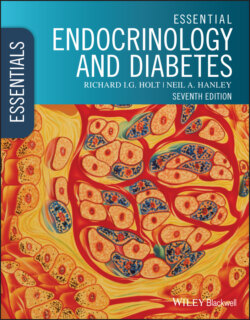Читать книгу Essential Endocrinology and Diabetes - Richard I. G. Holt - Страница 72
Diacylglycerol and Ca 2+
ОглавлениеSignalling from hormones, such as TRH, GnRH and oxytocin, recruits G‐protein complexes containing the Gqα subunit. This activates membrane‐associated phospholipase C, which catalyses the conversion of PI 4,5‐bisphosphate (PIP2) to DAG and IP3 (Figures 3.11 and 3.16). IP3 stimulates the transient release of calcium from the endoplasmic reticulum to activate several calcium‐sensitive enzymes, including isoforms of protein kinase C (PKC), and proteins like calmodulin (Figure 3.16). Calcium ions also activate cytosolic guanylate cyclase, an enzyme that catalyzes the formation of cyclic guanosine monophosphate (cGMP). The effects of atrial natriuretic peptide (ANP) are mediated by receptors linked to guanylate cyclase.
The major target of DAG signalling is PKC, which activates phospholipase A2 to liberate arachidonic acid from phospholipids and generate potent eicosanoids, including thromboxanes, leukotrienes, lipoxins and prostaglandins (Figure 3.17). The latter are well‐recognized paracrine and autocrine mediators capable of amplifying or prolonging a response to a hormonal stimulus.
Figure 3.12 Hormonal activation of G‐protein–coupled receptors can link to different second messenger pathways. The two alternative pathways are not mutually exclusive and may, in fact, interact.
